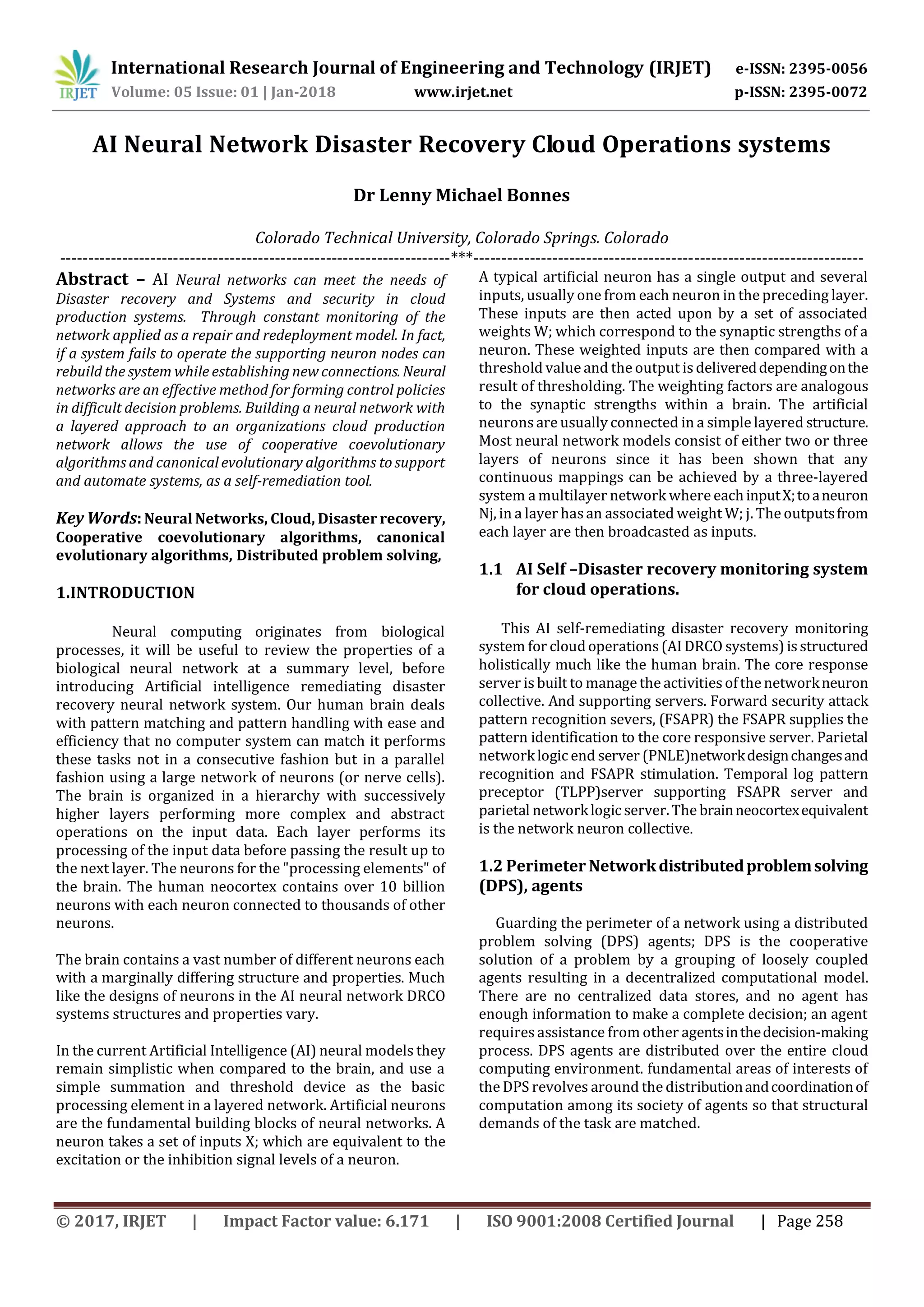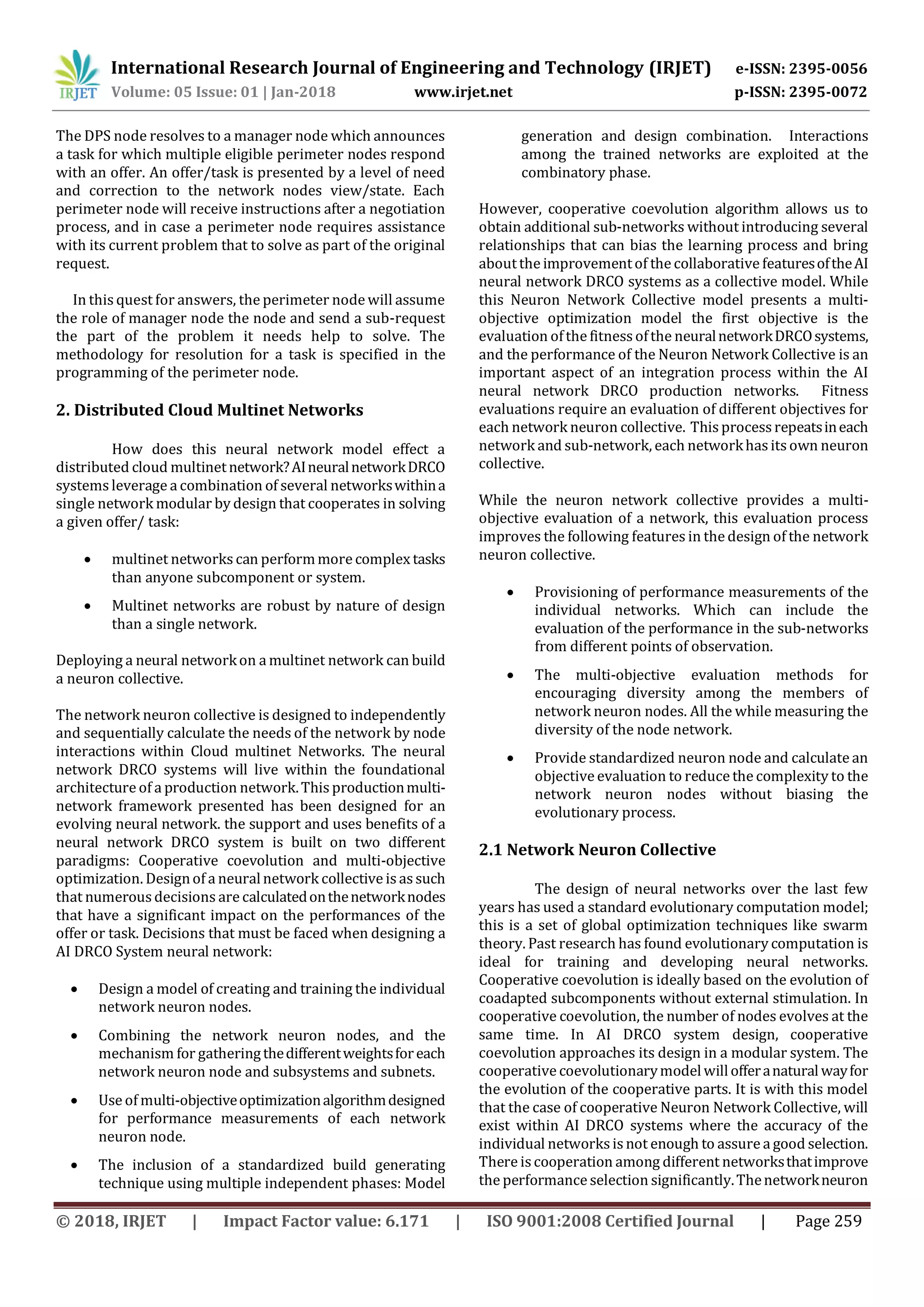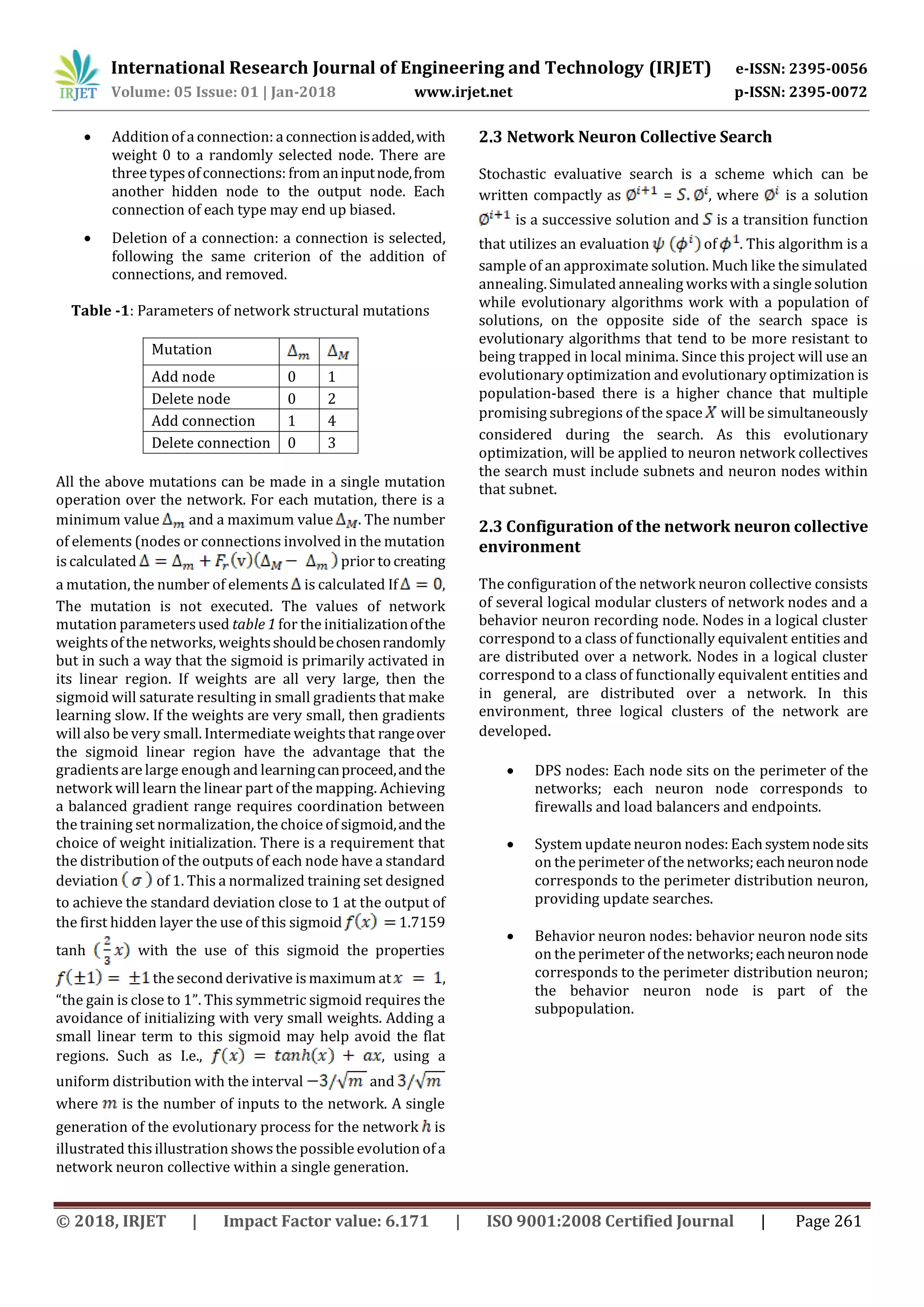AI neural networks can support disaster recovery and security operations in cloud computing systems. A neural network model is proposed that monitors a cloud computing network and can rebuild failed systems through new neural connections. The network uses cooperative coevolution algorithms and evolutionary algorithms to automate remediation. It involves distributed problem solving agents across the cloud network and a layered neural network collective that independently evaluates needs and repairs. This provides a robust, self-healing organizational model for cloud computing infrastructure and operations.


![International Research Journal of Engineering and Technology (IRJET) e-ISSN: 2395-0056
Volume: 05 Issue: 01 | Jan-2018 www.irjet.net p-ISSN: 2395-0072
© 2018, IRJET | Impact Factor value: 6.171 | ISO 9001:2008 Certified Journal | Page 260
collective model is based on two separate populations that
evolve cooperatively. These two populations are the
following.
The population of neuron Nodes: This population consists of
several independent subpopulations within a production
network. The evolution of subpopulations of networks is an
effective way of keeping the networks of different
populations diverse. The absence of inherited material
exchange among subpopulations produces a more diverse
network this combination is more effective every
subpopulation is evolved using evolutionary programming.
Networkneuron collective: eachnodeofthepopulationofthe
collective is a collectively formed by a network from every
network subpopulation. Each network has an associated
weight. The population of collectives keeps track of the best
combinations of networks, by selecting the subsets of
networks that are promising for the final collection.
The two populations, the network neuron collective and the
population of neuron nodes, evolve cooperatively. Each
generation of thewhole system consistsofagenerationofthe
network population followed by the generation of the
collective population. The learning process of the networks
must consider the cooperation among the networks for
obtaining better collectives. Cooperation among the
subpopulations in a cooperative coevolution helps develop
the learning process, it is necessary to force cooperation to
assure good results. This forced cooperationisdonebygiving
the neuron nodes several objectives for each network the
objectives will assist to encourage cooperation. Additionally,
every network is subject to backpropagation training [3]
through the evolution with a certain probability. This allows
the network to learn from the training set. The back-
propagation algorithm is implemented as a mutation
operator. The decision process must be made to design a
collective of neural networks.
2.2 Network Neuron Collective
Using a generalized multilayer perceptron, this GMLP
consists of an input layer, an output layer, and several
hidden neuron nodes interconnected among them.
Figure -1: Generalized Multilayer Perceptron
= ,
Where ) is the weight of the connection from node j to
node i. The representation of a GMLP is seen in figure 1 as
you see the ith node, is not an input node, it does have
connections from every jth node j< i. The main reason to
using GMLP is the evolution of networks. The structure
allows the definition of complex surfaces with fewer nodes
than a standard multilayer perceptron with one or two
hidden layers. Forming the network population by using
subpopulations. While using subpopulations with a fixed
number of networks it is necessary to codify the
subpopulations. Such as = , 1 . The
subpopulations are not fully connected. When a network is
initialized, each connection is created with a given
probability. The population is subject to operations of
replication and mutation. The algorithm for the evolution of
the subpopulations of networks is like other evolutionary
algorithms such as GNARL [4] or EPN [5] The steps for
generating the new subpopulations:
Networks of the initial subpopulation are created randomly.
The number of nodes of the network h is obtained from a
uniformdistribution Eachnodeiscreatedwith
several connections c taken from a uniform distribution
The new subpopulation is generated replicating the best P%
of the previous subpopulation. The remaining (1- P) % is
removed and replaced by mutated copies of networks
selected by randomized selection from the best P%
individuals.
There are two types of mutation within the neural network
design: parametric and structural. The severity of structural
mutation is determined by the relative fitness,
Where F (V) is the fitness value of network v,
and ∝ is a parameter that must be chosen. Parametric
mutation consists of the modification of the weights of the
network without changing its topology. Many parametric
mutation operators have been suggested in differing neural
network literature: such as random modification of the
weights, simulated annealing, and backpropagation, among
others.
Parametric mutation comprises the modification of the
weightsof the network without modifying itstopology.Many
parametric mutation operators have been suggested in
varying literature: random modification of the weights,
simulated annealing, and backpropagation.
In this research, the mutation operator uses a back-
propagation algorithm and is performed for a few iterations
with a low value of the learning coefficient η. Parametric
mutation is carried out after the structural mutation.
Structural mutation displays complexity in the modification
of the structure of the network. While retaining the
behavioral link between parents and their offspring this link
avoids generational gaps that can produce inconsistency in
the evolution algorithm. There are four different structural
mutations that will be applied to the network neuron
collective
Addition of a node: The node is added with no
connections to enforce the behavioral link with its
parent.
Deletion of a node: A node is randomly selected and
deleted together with its connections.](https://image.slidesharecdn.com/irjet-v5i154-180310080701/75/IRJET-AI-Neural-Network-Disaster-Recovery-Cloud-Operations-Systems-3-2048.jpg)

![International Research Journal of Engineering and Technology (IRJET) e-ISSN: 2395-0056
Volume: 05 Issue: 01 | Jan-2018 www.irjet.net p-ISSN: 2395-0072
© 2018, IRJET | Impact Factor value: 6.171 | ISO 9001:2008 Certified Journal | Page 262
Fig -1: Name of the figure
2.3 AI DPS system node design
Applicability of alternative optimization algorithm. This
section presents an evaluation of the applicability of
alternative optimization algorithms to the autonomous
security network agent. Given that the problem class has
multiple variables, constraints, and nonlinear objectives,the
goal is to select an optimization algorithm that can tackle
this broad class of integrated planning decision problems
that may be combinatorial in nature.
Rationale
Combinatorial problems incur a heavy penalty due to
dimensionality since the number of options grows
exponentially with the size of the inputs. Most combinatorial
optimization problems are NP-Hard constraints
Constraints
The problem model represents a set of linear equality
constraints restricting assignment of the decision variable
∅_ijk over the index space (I = 1,2,3…, p), (j = 1,2,3…, s), (k =
1,2, 3…, m). A linear equality constraint set written A∅=b,
where ∅ is a vectorization of the decision- variable vector,
and has a length l_c = (p*s*m), A is a l_r 〖xl〗_c matrix
comprising entries from the set {-1,0,1} and b is an l_r –
dimensional column vector. Including constraint(3.7)which
defines a workable space given by {x = {∅: A∅=b, ∅∈ Z^ (l_c)
+} which convex.
In this model of computation, the evolutionary algorithm at
any node performs an evolutionary search based on its
primary variable block using local and rapidly
accessible information, and it is assumed that accessing the
interconnection network for purposes of communication
between the nodes is delay prone, and so each node must
perform many local computations. Between cycles in the
interest of efficiency. Within the network, there can be
relative computational delays of the centralized and
distributed algorithms when they are implemented in a
network environment.
3. Agents design neural networks
The DPS agents start the evolutionary search by searching
each of the perimeter nodesfor available decision resources
and encoding references to the discrete choices in the
appropriate one or two or more alternative forms of
mutations or changes found at the same place on the nodes.
sets of its representation data structure. A certain mutation
of the network will set corresponding to a certain part node
type stores an encoded list of equivalent parts available for
spin up. All perimeter nodes act in a similar fashion to
mutations in the networks In this model of computation,
the evolutionary algorithm at any node performs an
evolutionary search based on its primary variable block
using locally accessible information, it is assumed that
accessing the interconnection network for purposes of
communication between the nodes is delay prone, and so
each node performs large number of local computations
between communication cycles. Given space andavariable
distribution, each node performs a local evolutionary
search in its primary subspace while the variables
corresponding to the secondary subspaces at a node are
secured. An intercommunication operation updates the
respective secondary variables at all nodes. Following this,
the local search proceedsusing updatedinformation,andthe
local and global operations of the distributed search
alternate, resulting in a cooperative search.Thesearchspace
in this computation is the product space of the p
subspaces and is given by
4. CONCLUSIONS
The applicability of AI Self–Remediating Disaster recovery
monitoring system for cloud operations. Can improve the
disaster recovery of many businesses that rely on cloud
computing. Many times, production and security lack the
personnel to patch update and recover systems due to the
lack of knowledgeable employees. This AI Self–Remediating
Disaster recovery monitoring system for cloud operations.
Fills the gap between HR resources and system resources.
REFERENCES
[1] C. H. M. D. O. B. Nicolas Garcia Pedrajas, "Cooperative
Coevolution of Artificial Neural Network Ensembles for
Pattern Classification.," IEEE transactions on evolutionary
computation, vol. 9, no. 3, p. 32, June 2005.
[2] J. W. Z.H. Zhou, "Ensembling Neural networks: Many
could be better than all," Artificial Intelligence, vol. 137, no.
1-2, pp. 239-253, May 2002.](https://image.slidesharecdn.com/irjet-v5i154-180310080701/75/IRJET-AI-Neural-Network-Disaster-Recovery-Cloud-Operations-Systems-5-2048.jpg)
![International Research Journal of Engineering and Technology (IRJET) e-ISSN: 2395-0056
Volume: 05 Issue: 01 | Jan-2018 www.irjet.net p-ISSN: 2395-0072
© 2018, IRJET | Impact Factor value: 6.171 | ISO 9001:2008 Certified Journal | Page 263
[3] P. J. Werbos, The roots of Backpropagation:fromordered
derivatives to Neural Networks and Political Forecasting,
New York: Wiley, 1994.
Dr. Lenny Mike Bonnes is a computer
scientist and an expert in Data Security
currently a Chief Information Security
officer
[4] X. a. Y.Liu, "A new evolutionary system for evolving
artificial neural networks," IEEE Trans. Neural Networks,
vol. 8, pp. 694-713, 1997.
BIOGRAPHY:](https://image.slidesharecdn.com/irjet-v5i154-180310080701/75/IRJET-AI-Neural-Network-Disaster-Recovery-Cloud-Operations-Systems-6-2048.jpg)